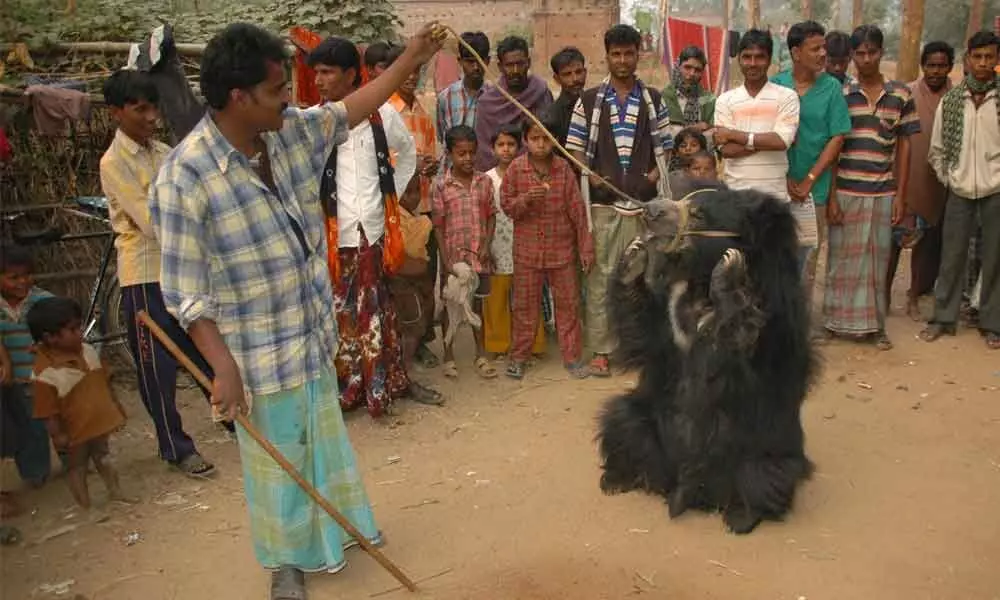Bengaluru: 'Dancing' bears find haven in Wildlife SOS

‘Dancing’ bears find haven in Wildlife SOS
The ‘dancing’ bear practice in India started around 400 years ago when a nomadic community entered the country from Persia and performed tricks to entertain Mughal emperors.
Bengaluru: The 'dancing' bear practice in India started around 400 years ago when a nomadic community entered the country from Persia and performed tricks to entertain Mughal emperors. While the monarchy faded away, sadly the 'dancing' bear trade stayed on, transitioning to a cheap street entertainment for tourists who paid to watch the bears.
Impoverished and pushed to the fringes of society, the nomadic community, known as the Kalandars, sustained themselves as beggars, using and exploiting sloth bears to 'dance' as a way to attract alms from tourists or collect grains and food from the rural people. This barbaric practice that supported illegal wildlife trafficking of sloth bear cubs has gone on long enough and it was time to do something about it.
Thus, started Wildlife SOS' flagship project to tackle this issue.
"Our journey has been quite a challenge, as it was difficult to gain the trust and cooperation from the Kalandars, who felt that we were attempting to take away their only means of survival. But over a time they realized that we wanted to provide a more sustainable solution for their families in the form of education for the children, an alternative livelihood program as well as women empowerment initiatives," said co-founder and CEO of Wildlife SOS, Kartick Satyanarayan.
Over the years, Wildlife SOS successfully rescued 628 sloth bears from this dancing bear practise and rehabilitated them in four large natural sanctuaries across India.
"Wildlife SOS in partnership with the Government of India was able to successfully and sustainably bring a permanent end to the practice of dancing bears in 2009. That said, the demand for sloth bear cubs and poaching is a large problem often stimulated by demand and supply forces from South East Asian countries that use sloth bear body parts as ingredients in traditional Chinese medicine. Poaching, habitat fragmentation and human wildlife conflict are some of the other serious threats to the wild sloth bear population in India," he added.
Even today the trade continues in some parts of Nepal for which bear cubs are smuggled.
"Similar to arms, human trafficking and narcotics, illegal wildlife trafficking (IWT) is a multi billion dollar industry and like any other crime, requires constant monitoring and continuous enforcement to be kept in check. For this, Wildlife SOS operates an anti-poaching unit- 'ForestWatch' that works in collaboration with State Forest Departments.
In fact, two year ago, 'Forestwatch' received intelligence that a group of poachers in possession of 5 sloth bears were hiding in a remote forested area in Jharkhand, which is located close to the Indo-Nepal border. The poachers were arrested by the forest department and police force based on intelligence provided by our team, and the bears were safely shifted to the Wildlife SOS Agra Bear Rescue Facility for lifetime care and rehabilitation," Satyanarayan said.
Wildlife SOS also assists the State Forest Departments (including Karnataka) in conducting bear rescue operations from situations of human-bear conflict, from poachers, bears that have been injured, sick and in distress.
Wildlife SOS has trained rescuers and wildlife veterinarians who accompany forest officials for rescue operations as well as off-site treatment of wild animals in distress. Although Wildlife SOS is mainly known for its work with the dancing bears, they also have active projects to help leopards, elephants, reptiles and other animals. They work on various projects targeted at environment and biodiversity conservation as well as reducing the carbon footprint. With the help of the dedicated staff and volunteers, grant programs and supportive agencies, both national and international, every day they renew the commitment to the animals and to find innovative ways to sustain and grow their mission.
The Bannerghatta Bear Rescue Center was created to eradicate the rampant and barbaric practice of "Dancing" Bears in southern part of India, Wildlife SOS with its mission to rescue and rehabilitate these Sloth Bears, saw the absolute need to establish a safe haven for them. These bears were rescued from situations of neglect, abuse and conflict, thus, requiring long-term intensive medical care and treatment.
Wildlife SOS in partnership with Karnataka Forest Department established the Bannerghatta Bear Rescue Centre in 2005. Since then, the Bannerghatta Bear Rescue Centre has been instrumental in rescuing and providing a life-time care for over a hundred Sloth Bears rescued from the Dancing Bear trade, poaching, and Human-Bear conflict situations. The centre is also home to bears that are sick, injured or orphaned, thus, cannot be released back into the wild.
Today, the Bannerghatta Bear Rescue Centre currently holds around 70 rescued Sloth Bears amidst the lush greens and rocks of the dry-deciduous Bannerghatta Biological Park, making it the world's second largest rescue centre for the Sloth Bears.
To ensure they remain mentally and physically stimulated, the caregivers at the Bannerghatta Bear Rescue Centre build and develop many enrichment structures for the bears to play with. These enrichments also encourage the bears to tap into their wild instincts and display natural behaviour. The centre also houses a well-equipped Veterinary Clinic and a team of experienced veterinary doctors to ensure round-the-clock care and monitoring of the animals in their care.
"When it came to rehabilitating our rescued bears, we ha e to start from scratch as for most of them a life at the end of the rope was all that they had known. Wildlife SOS also rescues wild animals from conflict situations or those that were found injured and in distress. Rescued animals receive veterinary treatment if required, and are kept under observation and if found fit for release are then released back into the wild. In cases where the animal cannot be released back into the wild due to the nature of its injuries, health condition or if they are orphaned cubs who cannot survive on their own in the wild, they are placed under lifetime care at our sanctuaries as issued by the forest department," Satyanarayan stated.














